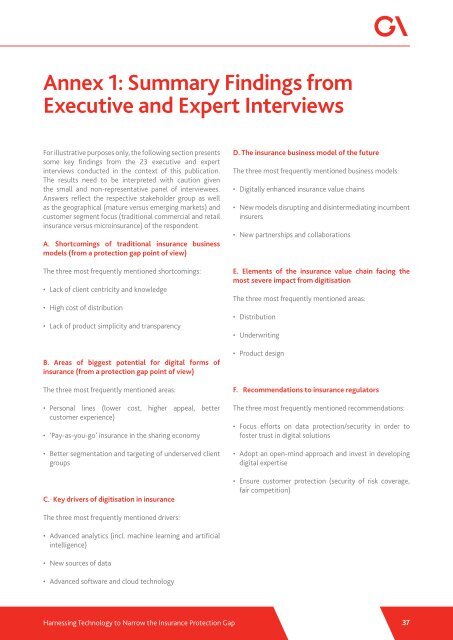Harnessing Technology to Narrow the Insurance Protection Gap
harnessing-technology-to-narrow-the-insurance-protection-gap
harnessing-technology-to-narrow-the-insurance-protection-gap
Create successful ePaper yourself
Turn your PDF publications into a flip-book with our unique Google optimized e-Paper software.
Annex 1: Summary Findings from<br />
Executive and Expert Interviews<br />
For illustrative purposes only, <strong>the</strong> following section presents<br />
some key findings from <strong>the</strong> 23 executive and expert<br />
interviews conducted in <strong>the</strong> context of this publication.<br />
The results need <strong>to</strong> be interpreted with caution given<br />
<strong>the</strong> small and non-representative panel of interviewees.<br />
Answers reflect <strong>the</strong> respective stakeholder group as well<br />
as <strong>the</strong> geographical (mature versus emerging markets) and<br />
cus<strong>to</strong>mer segment focus (traditional commercial and retail<br />
insurance versus microinsurance) of <strong>the</strong> respondent.<br />
A. Shortcomings of traditional insurance business<br />
models (from a protection gap point of view)<br />
The three most frequently mentioned shortcomings:<br />
• Lack of client centricity and knowledge<br />
• High cost of distribution<br />
• Lack of product simplicity and transparency<br />
B. Areas of biggest potential for digital forms of<br />
insurance (from a protection gap point of view)<br />
The three most frequently mentioned areas:<br />
• Personal lines (lower cost, higher appeal, better<br />
cus<strong>to</strong>mer experience)<br />
• ‘Pay-as-you-go’ insurance in <strong>the</strong> sharing economy<br />
• Better segmentation and targeting of underserved client<br />
groups<br />
C. Key drivers of digitisation in insurance<br />
D. The insurance business model of <strong>the</strong> future<br />
The three most frequently mentioned business models:<br />
• Digitally enhanced insurance value chains<br />
• New models disrupting and disintermediating incumbent<br />
insurers<br />
• New partnerships and collaborations<br />
E. Elements of <strong>the</strong> insurance value chain facing <strong>the</strong><br />
most severe impact from digitisation<br />
The three most frequently mentioned areas:<br />
• Distribution<br />
• Underwriting<br />
• Product design<br />
F. Recommendations <strong>to</strong> insurance regula<strong>to</strong>rs<br />
The three most frequently mentioned recommendations:<br />
• Focus efforts on data protection/security in order <strong>to</strong><br />
foster trust in digital solutions<br />
• Adopt an open-mind approach and invest in developing<br />
digital expertise<br />
• Ensure cus<strong>to</strong>mer protection (security of risk coverage,<br />
fair competition)<br />
The three most frequently mentioned drivers:<br />
• Advanced analytics (incl. machine learning and artificial<br />
intelligence)<br />
• New sources of data<br />
• Advanced software and cloud technology<br />
<strong>Harnessing</strong> <strong>Technology</strong> <strong>to</strong> <strong>Narrow</strong> <strong>the</strong> <strong>Insurance</strong> <strong>Protection</strong> <strong>Gap</strong><br />
37


